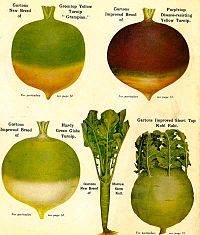Difference between revisions of "Roots, Tubers and By-Products"
| (8 intermediate revisions by 2 users not shown) | |||
| Line 1: | Line 1: | ||
==Turnips and Swedes== | ==Turnips and Swedes== | ||
| − | [[File:Turnips.jpg|200px|Turnips]] | + | [[File:Turnips.jpg|thumb|200px|right|Turnips]] |
===Characteristics=== | ===Characteristics=== | ||
Turnip and swede are related brassicas. They have good nutritive value, and typically a low dry matter and crude protein concentration. However, their protein tends to be very degradable. | Turnip and swede are related brassicas. They have good nutritive value, and typically a low dry matter and crude protein concentration. However, their protein tends to be very degradable. | ||
| Line 16: | Line 16: | ||
Excess intakes associated with milk taint in dairy cows. Nitrate and sulphur toxicity. | Excess intakes associated with milk taint in dairy cows. Nitrate and sulphur toxicity. | ||
<br> | <br> | ||
| − | |||
==Mangel, Fodderbeet and Sugarbeet== <!----Write below this line---> | ==Mangel, Fodderbeet and Sugarbeet== <!----Write below this line---> | ||
| − | [[File:Some Gartons Mangels.jpg|Mangel| | + | [[File:Some Gartons Mangels.jpg|Mangel|100px|right]] |
| − | [[File:Summerland Bungalow - geograph.org.uk - 731356.jpg|Fodderbeet|200px]] | + | [[File:Summerland Bungalow - geograph.org.uk - 731356.jpg|Fodderbeet|200px|right]] |
===Characteristics===<!----Write below this line---> | ===Characteristics===<!----Write below this line---> | ||
| Line 40: | Line 39: | ||
==Sugarbeet Pulp== <!----Write below this line---> | ==Sugarbeet Pulp== <!----Write below this line---> | ||
| − | [[File: | + | [[File:Sugar beet - geograph.org.uk - 1558767.jpg|Sugarbeet|200px|right]] |
===Characteristics===<!----Write below this line---> | ===Characteristics===<!----Write below this line---> | ||
Sugarbeet pulp is the residue following sugar extraction from sugarbeet root. It has a high dry matter and digestible fibre content, but a relatively low protein and phosphorus concentration. It is available in pellets or shreds, molassed or unmolassed. Can also be ensiled with distillers/brewers grains (draff) to form Grainbeet. | Sugarbeet pulp is the residue following sugar extraction from sugarbeet root. It has a high dry matter and digestible fibre content, but a relatively low protein and phosphorus concentration. It is available in pellets or shreds, molassed or unmolassed. Can also be ensiled with distillers/brewers grains (draff) to form Grainbeet. | ||
| Line 77: | Line 76: | ||
{{Learning | {{Learning | ||
| − | |flashcards = [[ | + | |flashcards = [[Animal Nutrition Flashcards]] |
}} | }} | ||
| − | [[Category: | + | [[Category:Animal Nutrition]] |
[[Category:To Do]] | [[Category:To Do]] | ||
Revision as of 15:51, 17 August 2011
Turnips and Swedes
Characteristics
Turnip and swede are related brassicas. They have good nutritive value, and typically a low dry matter and crude protein concentration. However, their protein tends to be very degradable.
| DM (%) | ME (MJ/kg DM) | CP (g/kg DM) | |
|---|---|---|---|
| Turnip | 9 | 11.2 | 120 |
| Swede | 12 | 12.8 | 110 |
Associated Problems
Excess intakes associated with milk taint in dairy cows. Nitrate and sulphur toxicity.
Mangel, Fodderbeet and Sugarbeet
Characteristics
These beets are very generally classified according to their DM content. Mangel < Fodderbeet < Sugarbeet. They are low in crude protein. Sugarbeets are primarily grown for sugar production, not feeding.
| DM (%) | ME (MJ/kg DM) | CP (g/kg DM) | |
|---|---|---|---|
| Mangel | 12 | 12.4 | 80 |
| Fodderbeet | 18 | 11.9 | 70 |
Associated Problems
Mangels have a high nitrate concentration if fresh (need to store for a few weeks). High intakes of fodderbeet can cause GI tract disturbances, hypocalcaemia and in rare cases death.
Sugarbeet Pulp
Characteristics
Sugarbeet pulp is the residue following sugar extraction from sugarbeet root. It has a high dry matter and digestible fibre content, but a relatively low protein and phosphorus concentration. It is available in pellets or shreds, molassed or unmolassed. Can also be ensiled with distillers/brewers grains (draff) to form Grainbeet.
| DM (%) | ME (MJ/kg DM) | CP (g/kg DM) | |
|---|---|---|---|
| SB pulp (unmolassed) | 90 | 12.7 | 100 |
| SB pulp (molassed) | 87 | 12.5 | 110 |
Associated Problems
Choke, especially in horses (can increase it’s volume up to 6x; recommended to soak (ca. 1 litre per 200g) for 24 hours prior to feeding to horses).
Molasses
Characteristics
Molasses is the residue following sugar extraction from sugarbeet root (also get molasses from sugarcane). It involves crystallisation and separation of sugar from water extract. Molasses is a thick, black liquid that is very low in protein concentration but very high in soluble sugars. It is often added to sugarbeet pulp, proprietary feeds, mineral licks, and TMR rations.
| DM (%) | ME (MJ/kg DM) | CP (g/kg DM) | |
|---|---|---|---|
| Molasses | 75 | 12.9 | 50 |
Associated Problems
Can be laxative. Acidosis at high intakes.
| Roots, Tubers and By-Products Learning Resources | |
|---|---|
 Test your knowledge using flashcard type questions |
Animal Nutrition Flashcards |




